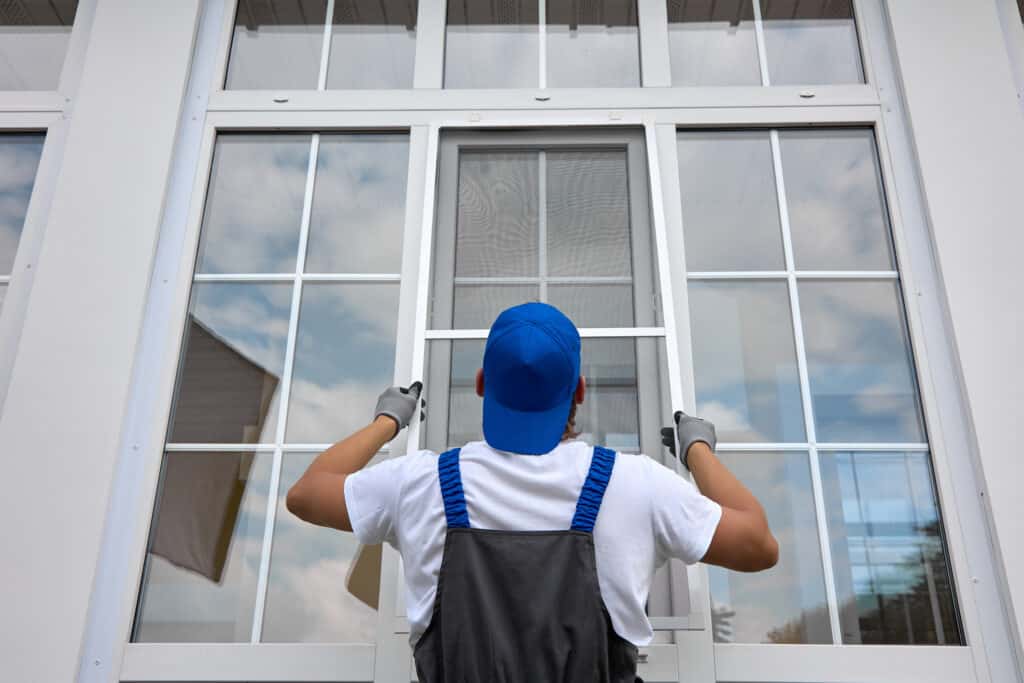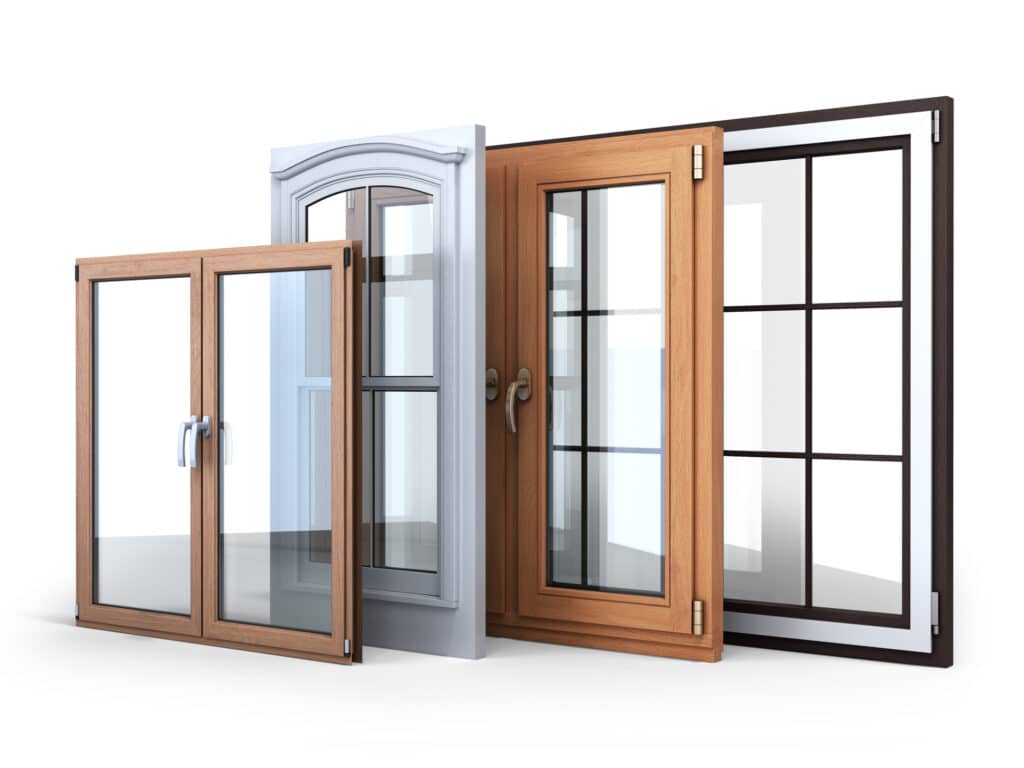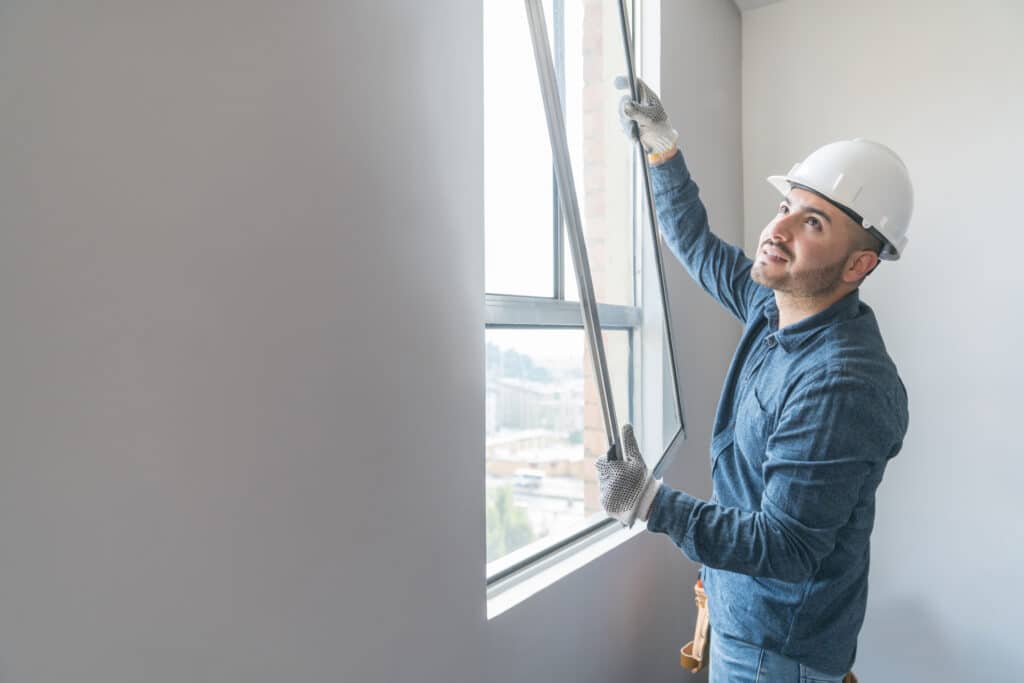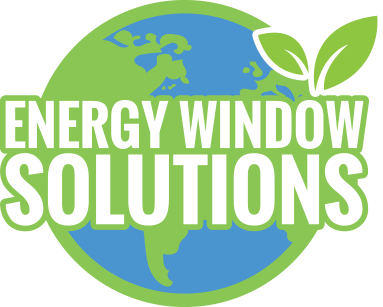
Top 5 Sustainable Window Materials
Choosing eco-friendly window materials can lower your carbon footprint, boost energy efficiency, and increase home value. Here are the top 5 sustainable window materials:
- Recycled Aluminum: Durable, highly recyclable, and energy-efficient with thermal breaks.
- Sustainably Sourced Wood: Renewable, biodegradable, and excellent for insulation.
- Fiberglass: Strong, low-maintenance, and made from recycled glass for superior insulation.
- Composite Materials: Combines wood and plastic for durability and energy efficiency.
- uPVC: Weather-resistant, energy-efficient, and cost-effective with minimal maintenance.
These options help make your home greener and more efficient.

Are you looking to upgrade your home’s windows but want to make an eco-friendly choice? With sustainability becoming a top priority for homeowners in areas like Plano, TX, and beyond, choosing the right window materials can make a big difference.
Not only do sustainable windows help reduce your carbon footprint, but they also improve energy efficiency and add value to your home.
In this guide, we’ll explore the top 5 sustainable window materials that can help you create a greener, more energy-efficient home.
What Makes a Window Material Sustainable?
When it comes to sustainability, not all window materials are created equal. Sustainable window materials are those that have a minimal impact on the environment throughout their lifecycle—from production to disposal.
This means they are often made from recycled or renewable resources, have long lifespans, and contribute to energy efficiency in your home.
For example, a material like recycled aluminum is considered sustainable because it can be recycled multiple times without losing quality.
On the other hand, sustainably sourced wood is harvested in a way that preserves the environment and supports responsible forestry practices.
Energy efficiency is also a key factor. Sustainable windows help reduce your energy bills by keeping your home well-insulated, which is great for the environment and your wallet.
Importance of Choosing Sustainable Windows
Choosing sustainable windows isn’t just about being environmentally conscious—it’s about making a smart investment in your home. In regions like Plano, TX, Lewisville, TX, and Flower Mound, TX, where temperatures can fluctuate, having the right windows can greatly affect your home’s comfort and energy usage.
Sustainable windows provide excellent insulation, keeping your home warm in the winter and cool in the summer. This means lower energy bills and a reduced carbon footprint. Additionally, sustainable window materials are often more durable and require less maintenance, saving you time and money in the long run.
Beyond the practical benefits, sustainable windows contribute to a healthier environment by using materials that are either renewable or recyclable. They also help reduce the overall energy consumption of your home, which is a win for both your wallet and the planet.
Top 5 Sustainable Window Materials
When it comes to making your home more eco-friendly, selecting the right window materials is a significant step.
Sustainable window materials not only reduce your carbon footprint but also improve energy efficiency, durability, and the overall aesthetic of your home. Here’s an in-depth look at the top 5 sustainable window materials that stand out in the market today.
1. Recycled Aluminum
Recycled aluminum is a powerhouse in the realm of sustainable building materials, especially when it comes to windows. This material is prized for its combination of strength, lightness, and impressive ability to be recycled over and over without degrading in quality.
- High recyclability: Aluminum is one of the most recyclable materials available. When aluminum windows are made from recycled aluminum, they reduce the need for new raw materials, conserving natural resources and reducing environmental impact.
- Energy efficiency: Aluminum windows can be engineered with thermal breaks—insulating barriers that prevent heat loss. This feature ensures that your windows contribute to maintaining a comfortable indoor climate, reducing the need for excessive heating or cooling.
- Durability: Recycled aluminum is naturally resistant to corrosion, which makes it ideal for long-lasting window frames. It doesn’t warp, swell, or crack over time, even in extreme weather conditions, ensuring your windows look great and perform well for decades.
Choosing recycled aluminum for your windows not only supports recycling efforts but also provides you with a durable, low-maintenance, and energy-efficient window option.
2. Sustainably Sourced Wood
Wood has long been a favorite material for window frames due to its natural beauty and excellent insulation properties. However, the sustainability of wood depends largely on how it is sourced. Sustainably sourced wood comes from forests that are managed with strict ecological and social standards to ensure that the environment and local communities are protected.
- Renewable resource: Sustainably sourced wood is harvested in a way that ensures the forest can regenerate and continue to provide resources without harming the ecosystem. This practice helps maintain biodiversity and forest health.
- Biodegradable: Unlike synthetic materials, wood is biodegradable, which means it will naturally break down at the end of its life cycle, reducing waste in landfills.
- Energy efficiency: Wood naturally insulates well, reducing energy loss through windows. This helps keep your home warm in the winter and cool in the summer, reducing the need for artificial heating and cooling.
By choosing windows made from sustainably sourced wood, you’re investing in a renewable resource that supports sustainable forestry practices and reduces your environmental footprint.
3. Fiberglass
Fiberglass windows are increasingly popular for those seeking both durability and sustainability. Made from fine strands of glass woven together, fiberglass is strong, resilient, and offers superior insulation properties.
- Superior insulation: Fiberglass doesn’t expand or contract with temperature changes, which maintains a consistent seal around your windows. This tight seal is crucial for preventing air leaks, which can significantly reduce your energy bills by improving your home’s insulation.
- Durability: Fiberglass is one of the most durable window materials available. It is resistant to rot, corrosion, and pests, making it a low-maintenance option that can last for decades.
- Eco-friendly production: Fiberglass windows are often made from recycled glass, reducing the demand for raw materials. Additionally, the production process for fiberglass is less energy-intensive compared to other materials, which further enhances its sustainability credentials.
Choosing fiberglass windows means investing in a product that offers longevity, energy efficiency, and a reduced environmental impact, making it a wise choice for the eco-conscious homeowner.
4. Composite Materials
Composite windows are a versatile option that combines the best qualities of different materials to create a high-performance, sustainable product. Typically made from a blend of wood fibers and plastic, composite windows offer the appearance of wood with enhanced durability and less maintenance.
- Energy efficiency: Composite windows often feature high insulation values, making them effective at reducing energy loss. This can lead to lower heating and cooling costs, making your home more energy-efficient.
- Low maintenance: Unlike traditional wood, composite materials are resistant to rot, warping, and insect damage, which means they require minimal maintenance. This durability extends the life of your windows, reducing the frequency of replacements and the associated environmental impact.
- Eco-friendly: Many composite windows are made from recycled or sustainably sourced materials, making them a responsible choice for those looking to reduce their environmental footprint. The production process for composites also tends to use less energy and produce fewer emissions compared to the manufacturing of some other window materials.
By choosing composite windows, you’re opting for a product that combines sustainability with practical benefits like energy efficiency, durability, and low maintenance, all while maintaining a natural look.
5. uPVC (Unplasticized Polyvinyl Chloride)
uPVC, or unplasticized polyvinyl chloride, is a popular choice for sustainable windows due to its strength, durability, and low maintenance needs. Unlike traditional PVC, uPVC does not contain harmful plasticizers, making it a more environmentally friendly option.
- Durability: uPVC windows are known for their long lifespan, often lasting 20 to 30 years or more without needing replacement. They are resistant to weathering, meaning they won’t rot, rust, or corrode, even in harsh climates.
- Energy efficiency: uPVC is an excellent insulator, helping to keep your home warm in winter and cool in summer. This reduces the need for excessive heating or cooling, which can significantly lower your energy bills.
- Low maintenance: uPVC windows require very little maintenance. They don’t need to be painted, and they are easy to clean with just soap and water. This reduces the need for chemical treatments and extends the life of your windows.
uPVC windows offer a cost-effective, sustainable option for homeowners who want durable, energy-efficient windows that require minimal upkeep. They are an ideal choice for those looking to balance affordability with environmental responsibility.

Criteria for Choosing Sustainable Window Materials
Energy Efficiency
Energy efficiency is one of the most important factors when choosing window materials. Sustainable windows should help keep your home comfortable year-round by providing excellent insulation.
This reduces the need for excessive heating in the winter or cooling in the summer, leading to lower energy bills. Look for materials that offer high thermal resistance, such as fiberglass or composite materials.
Additionally, double or triple glazing can enhance the energy efficiency of your windows by minimizing heat transfer, while thermal breaks in materials like aluminum can further improve insulation.
Durability and Lifespan
The durability and lifespan of your window materials play a significant role in their sustainability. Durable materials require fewer replacements, which means less waste and lower costs over time.
For example, materials like uPVC are known for their resistance to weather conditions, making them ideal for areas with high humidity. Fiberglass, on the other hand, is excellent for extreme temperature variations.
Materials like composite or recycled aluminum are also valued for their ability to resist warping, rotting, or corroding, making them a long-term investment that can lead to significant savings over time.
Maintenance Requirements
Maintenance requirements are another important consideration when choosing sustainable window materials. Low-maintenance options not only save you time but also reduce the need for chemicals or other treatments that can be harmful to the environment.
Materials like uPVC and fiberglass are easy to clean and require minimal upkeep. While sustainably sourced wood may need occasional refinishing to maintain its appearance, composite materials generally do not require such treatments.
Opting for materials with low maintenance needs ensures that your windows will remain in good condition with minimal effort, contributing to the overall sustainability of your home.
Cost Considerations
Cost considerations often play a significant role in the decision-making process. While sustainability is crucial, the cost of materials and installation is often a deciding factor for homeowners.
It’s important to balance the upfront cost with the long-term benefits, including energy savings and reduced maintenance. Some materials, like recycled aluminum or composite, might have higher initial costs but offer significant long-term savings.
More energy-efficient windows can lead to lower utility bills, offsetting the initial investment over time. Durable materials that last longer reduce the need for replacements, which can save money in the long run.
Considering both the short-term and long-term costs helps you make a financially sound decision that also supports your sustainability goals.
How to Make the Right Choice for Your Home
Selecting the right sustainable window material involves more than just picking the most eco-friendly option. You also need to consider your home’s specific needs, the local climate, and your budget to ensure you make the best choice.
Assessing Your Home’s Specific Needs
Every home is unique, and what works for one might not work for another. Start by evaluating your home’s existing structure and the style you want to maintain or achieve.
For example, if you live in an older home, you might prefer the classic look of sustainably sourced wood. On the other hand, if you’re aiming for a modern aesthetic, recycled aluminum or composite materials might be a better fit.
Consider how the windows will complement your home’s architecture while also providing the necessary insulation and durability.
Climate Considerations
The climate in your area plays a significant role in determining the best window materials for your home. In regions like Plano, TX, where summers are hot and winters can be chilly, it’s essential to choose materials that offer excellent thermal performance.
Fiberglass and composite materials, for example, perform well in extreme temperatures, maintaining their insulating properties without warping or cracking.
uPVC is also a great choice for areas with high humidity, as it resists moisture and prevents mold growth. Tailoring your window choice to your local climate ensures that your home remains comfortable year-round.
Budget Planning for Sustainable Upgrades
While sustainable materials often come with a higher upfront cost, they can lead to long-term savings through reduced energy bills and lower maintenance requirements. When planning your budget, consider both the initial investment and the potential return on investment (ROI) over time.
Energy-efficient windows, for instance, can significantly reduce your heating and cooling costs, which may offset the higher initial expense. Additionally, durable materials that require less frequent replacement can save money in the long run.
If budget constraints are a concern, prioritize the most critical areas for upgrading, such as windows in rooms with the most exposure to sunlight or drafts.

Installation Considerations for Sustainable Windows
Importance of Professional Installation
Professional installation is crucial to ensure that your sustainable windows function correctly and efficiently. Proper installation prevents air leaks and moisture infiltration, which can compromise energy efficiency.
Professionals have the expertise and tools to handle various materials, ensuring a perfect fit. A well-installed window enhances durability and comes with warranties for added peace of mind. Investing in professional installation ensures that your windows provide long-term benefits.
Common Pitfalls to Avoid During Installation
One common pitfall is improper sealing, leading to drafts and water leaks. It’s important to use high-quality sealants and weatherstripping to maintain an airtight seal. Another issue is neglecting to address structural problems around the window opening, which can affect the installation’s integrity.
Rushing the installation process can result in poor performance and a reduced lifespan for your windows. Ensuring careful, thorough installation is key to maximizing your windows’ efficiency and durability.
Ready to Upgrade to Sustainable Windows? Let’s Make It Happen!
Choosing the right window materials can transform your home into an energy-efficient haven while reducing your environmental impact. At Energy Window Solutions, we specialize in providing top-quality, sustainable window options tailored to your needs.
Whether you’re in Plano, TX, Lewisville, TX, or Flower Mound, TX, our expert team is here to guide you through the process, ensuring your home is both beautiful and eco-friendly.
Don’t wait to enhance your home’s efficiency and value—contact us today to start your sustainable window upgrade journey!
FAQs: Sustainable Window Materials
What is the most eco-friendly window material?
Recycled aluminum and sustainably sourced wood are among the most eco-friendly window materials. Recycled aluminum is durable and recyclable, while sustainably sourced wood is a renewable option. Both materials minimize environmental impact, making them ideal for eco-conscious homeowners.
How do sustainable windows improve home value?
Sustainable windows made from window materials like fiberglass or composite enhance energy efficiency and home aesthetics. These improvements lower utility costs and attract potential buyers. Investing in sustainable windows can significantly boost your home’s market value.
Are there tax credits or incentives for sustainable windows?
Tax credits or incentives are often available for energy-efficient window materials. These incentives can help reduce the overall cost of your investment. Check with local authorities to see what’s available in your area.
What are the benefits of using composite window materials?
Composite window materials offer durability, energy efficiency, and low maintenance. They resist weathering, rot, and pests while providing excellent insulation. Their long lifespan also contributes to cost savings and environmental sustainability.
How do I choose the best window materials for my climate?
Selecting the best window materials involves considering local weather conditions. For example, fiberglass is great for hot climates, while uPVC is ideal for humid areas. Matching the material to your climate ensures optimal performance and longevity.


